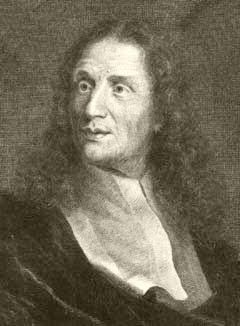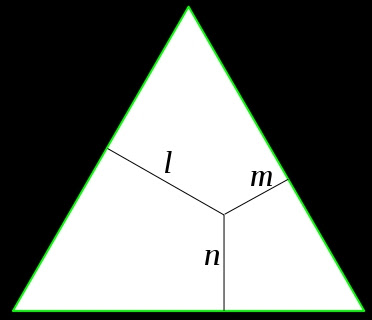Philosophy
 Vincenzo Viviani
Vincenzo Viviani
April 5th, 1622 to September 22nd, 1703
Can't let the day fade without the mention of Vincenzo Viviani born on this date in 1622.
Bill Ashworth in the Linda Hall Library Newsletter wrote...
When just a lad of 16, Viviani so impressed the Duke of Florence with his mathematical talent that he was assigned as secretary to the aging and blind Galileo. Viviani moved into Galileo's villa at Arcetri and lived there for the last three years of Galileo's life. After Gaileo's death in 1642, Viviani published several important mathematical works of his own, but he gave high priority to his role as conservator of Galileo's memory and work. In 1654, he wrote a biography of his hero; it was intended for inclusion in the 1656 edition of Galileo's Opere, but it was not published there, instead appearing only in 1717. Nevertheless, Viviani’s Life of Galileo was the principal source for information on Galileo until the 20th century. And in it are two famous stories: one says that Galileo discovered the law of pendulums by observing the swinging chandeliers in the Pisa Cathedral; the other states that Galileo demonstrated the fallacy of Aristotle’s laws of falling bodies by dropping weights from the top of the Tower of Pisa. Both stories became part of Galileo lore and are still often retold. Neither story, alas, appear to be true. We have a pretty little 1826 edition of Viviani’s Vita di Galileo in the History of Science Collection, as well as the monumental Opere di Galileo, published in 20 volumes between 1890-1909, and made possible by Viviani’s diligent collecting of Galileo’s manuscripts and correspondence.
Vincenzo Viviani [Wikipedia]

Viviani's theorem [Wikipedia]
- Doing Science...giovanni Battista Riccioli Does It Right
The Italian astronomer Giovanni Battista Riccioli is commonly credited with performing the first precise experiments to determine the acceleration of a freely falling body. Riccioli has been discussed by historians of science, sometimes positively but...
- Macabre...galileo's Lost Tooth And Fingers
Maybe not as macabre as you think. Remember Einstein's brain . "Art collector finds Galileo's lost tooth, fingers" November 20th, 2009 Reuters An art collector has found a tooth, thumb and finger of the renowned Italian scientist Galileo Galilei...
- Galileo's Discovery Of Neptune
Wikipedia: Galileo's drawings show that he first observed Neptune on December 28, 1612, and again on January 27, 1613. On both occasions, Galileo mistook Neptune for a fixed star when it appeared very close—in conjunction—to Jupiter in the night...
- "sidereus Nuncius"--published March 13th, 1610
The Stephen Hawking of the 17th Century. Title page of Galileo's Sidereus Nuncius, published in Venice in 1610. The book instantly made Galileo a European celebrity, and earned him, in July 1610, the position of chief mathematician and philosopher...
- Double Star Observations--galileo Galilei
Galileo Galilei Demonstrates His Astronomical Theories to a Monk This is somewhat unusual...that earlier observations of double stars negated the conclusions written in Galileo Galilei's Dialogue Concerning the Two Chief World Systems [1632]...such...
Philosophy
Vincenzo Viviani...secretary to Galileo and the Viviani theorem
 Vincenzo Viviani
Vincenzo VivianiApril 5th, 1622 to September 22nd, 1703
Can't let the day fade without the mention of Vincenzo Viviani born on this date in 1622.
Bill Ashworth in the Linda Hall Library Newsletter wrote...
When just a lad of 16, Viviani so impressed the Duke of Florence with his mathematical talent that he was assigned as secretary to the aging and blind Galileo. Viviani moved into Galileo's villa at Arcetri and lived there for the last three years of Galileo's life. After Gaileo's death in 1642, Viviani published several important mathematical works of his own, but he gave high priority to his role as conservator of Galileo's memory and work. In 1654, he wrote a biography of his hero; it was intended for inclusion in the 1656 edition of Galileo's Opere, but it was not published there, instead appearing only in 1717. Nevertheless, Viviani’s Life of Galileo was the principal source for information on Galileo until the 20th century. And in it are two famous stories: one says that Galileo discovered the law of pendulums by observing the swinging chandeliers in the Pisa Cathedral; the other states that Galileo demonstrated the fallacy of Aristotle’s laws of falling bodies by dropping weights from the top of the Tower of Pisa. Both stories became part of Galileo lore and are still often retold. Neither story, alas, appear to be true. We have a pretty little 1826 edition of Viviani’s Vita di Galileo in the History of Science Collection, as well as the monumental Opere di Galileo, published in 20 volumes between 1890-1909, and made possible by Viviani’s diligent collecting of Galileo’s manuscripts and correspondence.
Vincenzo Viviani [Wikipedia]

h=l + m + n
Vincenzo Viviani is also the formulator of a geometry theorem named after him...the Viviani theorem where "...the sum of the distances from a point to the sides of an equilateral triangle equals the length of the triangle's altitude."Viviani's theorem [Wikipedia]
- Doing Science...giovanni Battista Riccioli Does It Right
The Italian astronomer Giovanni Battista Riccioli is commonly credited with performing the first precise experiments to determine the acceleration of a freely falling body. Riccioli has been discussed by historians of science, sometimes positively but...
- Macabre...galileo's Lost Tooth And Fingers
Maybe not as macabre as you think. Remember Einstein's brain . "Art collector finds Galileo's lost tooth, fingers" November 20th, 2009 Reuters An art collector has found a tooth, thumb and finger of the renowned Italian scientist Galileo Galilei...
- Galileo's Discovery Of Neptune
Wikipedia: Galileo's drawings show that he first observed Neptune on December 28, 1612, and again on January 27, 1613. On both occasions, Galileo mistook Neptune for a fixed star when it appeared very close—in conjunction—to Jupiter in the night...
- "sidereus Nuncius"--published March 13th, 1610
The Stephen Hawking of the 17th Century. Title page of Galileo's Sidereus Nuncius, published in Venice in 1610. The book instantly made Galileo a European celebrity, and earned him, in July 1610, the position of chief mathematician and philosopher...
- Double Star Observations--galileo Galilei
Galileo Galilei Demonstrates His Astronomical Theories to a Monk This is somewhat unusual...that earlier observations of double stars negated the conclusions written in Galileo Galilei's Dialogue Concerning the Two Chief World Systems [1632]...such...
